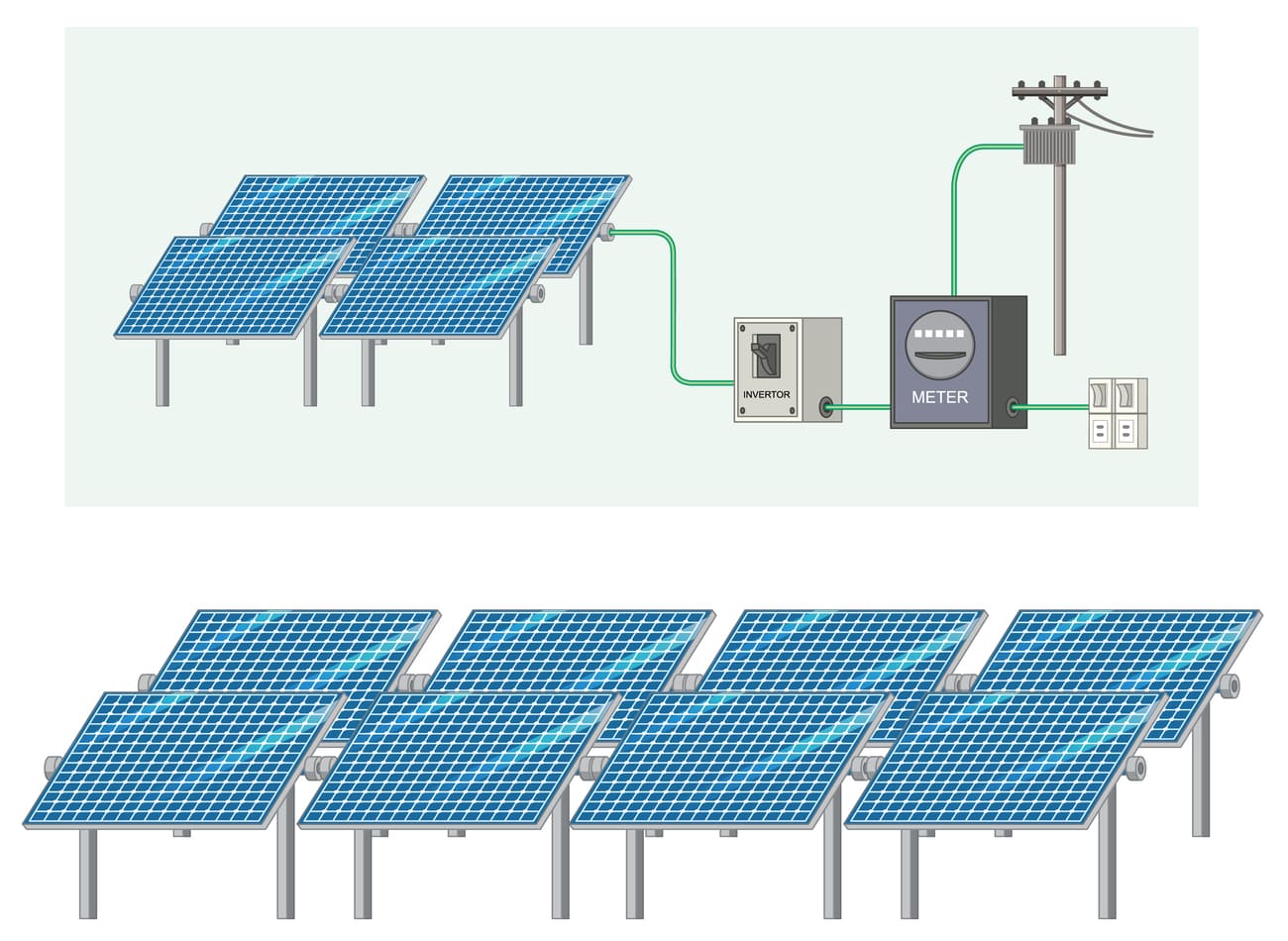

Solar panels connect to the electrical grid through a utility interconnection process that requires authorization from your local utility company. This two-phase procedure includes authorization to install (reviewing system plans) and authorization to operate (inspecting the completed installation), typically taking 2-4 weeks and costing $0-$200 for most homeowners.
The interconnection process ensures your solar system meets safety standards before generating electricity. Your utility company reviews engineering plans, confirms grid capacity, installs a bi-directional meter to track energy flow, and verifies your system automatically shuts down during power outages to protect utility workers. Once you receive Permission to Operate (PTO), your solar panels can begin producing power and earning net metering credits where available.
Here's everything you need to know about connecting your solar installation to the utility grid, including required documentation, inspection timelines, common rejection reasons, and why this safety verification process protects both homeowners and electrical infrastructure.
Interconnection represents the procedure through which a solar homeowner submits requests and obtains authorization from their regional utility provider to link with the electrical grid.
When partnering with a professional solar installer, they typically manage the interconnection procedure for you. However, understanding what occurs during this phase of your solar installation journey remains valuable.

Securing authorization from your electrical provider is mandatory to link your solar energy installation to the utility network so your panels can begin producing power for your residence and accumulating net metering benefits (where applicable). According to the International Energy Agency's renewable energy outlook, grid-connected solar systems are becoming increasingly common worldwide. Typically, the solar interconnection procedure divides into two primary phases: authorization to install and authorization to operate. Certain utilities mandate only an authorization to operate without requiring installation approval.
Though specific requirements differ across utility providers, the core objective stays consistent: Confirming your solar power installation is correctly engineered and set up, ensuring safety for your property and the electrical network.
Simultaneously, any Authority Having Jurisdiction (AHJ, which is the municipal building authority governing your location) must greenlight major construction activities, including solar power installations. Consequently, your solar provider will pursue permits while concurrently advancing interconnection to accelerate the overall timeline. The SolSmart solar permitting initiative provides valuable resources for understanding local requirements, and you can learn more about how solar permit expediting services work to streamline your approval process.
When your utility mandates requesting authorization to install within the interconnection procedure, your solar design provider will file an application with your utility company to examine the electrical blueprints, equipment details, and complete system architecture. Their objective is verifying the electrical components satisfy all relevant standards for interconnection.
Your solar provider files an interconnection request with your utility company for authorization to install, potentially including:
The utility company examines the request for correctness and compliance with interconnection requirements. The IEEE Power & Energy Society sets many of the technical standards that utilities reference during this review process.
The utility company confirms network capacity availability and validates that all technical specifications align with utility requirements.
When all conditions are satisfied and network capacity is verified, the utility will grant installation approval.
Throughout steps 2 and 4, the request may be returned by the utility company. Should this occur, your solar installer must implement revisions or supply extra information before authorization can be issued.
Following your installation completion and successful passage of all mandatory inspections, your solar contractor initiates the second phase of the interconnection procedure, commonly known as requesting authorization to operate, or PTO. While authorization to install demands a review of the installation blueprints, authorization to operate necessitates an evaluation of the finished installation. Understanding solar rapid shutdown compliance requirements is crucial during this phase.
Your solar provider submits a 'Part 2' interconnection request to your utility company for authorization to operate, and it may include:
The utility company evaluates your solar power installation, examining for any concerns. Some utilities dispatch their personnel to your property for an on-site evaluation, while others may authorize remotely based on installation photographs. If the solar components are positioned outdoors, you may not need to be present during this phase, but if the inverter or AC disconnect is in the garage, you will likely need to be available to provide utility personnel access.
If the installation fails to satisfy utility standards, particularly regarding wire management and conduit practices, the solar contractor will implement modifications and then resubmit for PTO.
Throughout the installation procedure, the utility will 'reset' or 'swap' your electric meter to a bi-directional meter that can precisely measure kilowatt-hours (kWh) traveling from the grid to your property and surplus solar energy generation your property does not consume that travels to the grid.
Once your solar energy installation receives authorization to operate, you can activate your system and begin producing electricity. The U.S. Department of Energy's homeowner guide provides additional information about maximizing your solar investment through available tax credits.

The interconnection procedure for residential solar can require anywhere from two to four weeks on average, depending on your utility company and system capacity. For commercial solar design projects, timelines may vary based on system complexity and local regulations.
The expense for interconnection can depend on your utility, your property's position in relation to the electric grid, and your solar system capacity. For most property owners, this ranges from no expense to approximately $200, and it will be incorporated in the total expense of your system.
Clear and established interconnection procedures are critical for public safety. Utility companies need to evaluate every interconnection to the grid so people, property, and systems are kept safe and secure. The World Bank's energy sector analysis emphasizes the importance of proper grid integration for renewable energy systems.
Solar power installations that are linked to the grid are engineered to shut down automatically during power disruptions to ensure solar electricity does not endanger utility workers. Solar power installations with battery storage can be engineered to continue generating solar electricity while ensuring that all surplus generation is stored in the battery and not transmitted to the grid during power disruptions. This is known as solar islanding. For those interested in systems that operate independently, off-grid solar system design offers alternative solutions.
Throughout the interconnection procedure, the utility confirms that the safety protocols necessary to link your solar power installation with the grid are in place and functioning. Understanding whether you need a supply-side or load-side interconnection is an important technical consideration. It also configures your electric bill for net metering if available, which ENERGY STAR's home energy savings program can help you understand better.
Your solar provider should employ interconnection specialists who stay current with existing procedures for every utility company they work with, ensuring a smooth interconnection procedure. Resources from the American Solar Energy Society and National Renewable Energy Laboratory provide ongoing education about best practices in solar interconnection.
It's important to have your planned installation and your finished installation evaluated so everyone is kept safe when your system is linked to the utility grid.
Procedures, timelines, and standards will vary by utility company, but working with a qualified solar provider will ensure the process runs smoothly. Before you know it, your solar panels will be producing clean energy and reducing your bills. The EPA's Green Power Markets program offers additional insights into the environmental benefits of grid-connected renewable energy.
If you want to learn more about getting solar panels installed on your property, consult with a reputable solar installer today. You can explore our comprehensive blog resources to learn more, or if you're considering a hands-on approach, check out whether professional installation or DIY saves you more. For technical enthusiasts, our guide on building your own home solar power system and understanding solar supply-side connections provides valuable DIY insights. Green Building Advisor also offers excellent resources for integrating solar into your home construction or renovation projects.
The utility interconnection process represents a fundamental step in your solar journey that transforms your installation from a collection of panels into a fully functional, grid-connected power system. While the procedure may seem complex with its various authorizations, inspections, and documentation requirements, understanding each phase helps you know what to expect as you transition to clean energy.
Working with a qualified solar provider ensures that both the authorization to install and authorization to operate phases are handled professionally, minimizing delays and complications. Though the interconnection timeline typically spans two to four weeks, the wait is worthwhile. Once your utility grants final approval, your solar panels can begin producing electricity, reducing your energy bills, and contributing to a more sustainable future.
The interconnection procedure exists not as a bureaucratic obstacle but as an essential safety mechanism protecting homeowners, utility workers, and the electrical grid itself. By ensuring your system meets all technical standards and safety requirements, the interconnection process guarantees your solar installation operates reliably and safely for decades to come.
As you move forward with your solar installation, stay informed about the interconnection progress and maintain open communication with your solar provider. Before long, you'll flip the switch on your new solar energy system and start enjoying the financial and environmental benefits of renewable energy.
How long does the solar interconnection process take?
The solar interconnection process typically takes anywhere from two to four weeks on average, though this timeline can vary depending on your specific utility company, system capacity, and local requirements. Some utilities process applications more quickly, while others may take longer due to high application volumes or additional review requirements. Your solar provider can give you a more accurate timeline based on their experience with your local utility company.
How much does interconnection cost for a residential solar system?
For most homeowners, interconnection costs range from no expense to approximately $200. The actual cost depends on several factors including your utility company's fee structure, your property's location relative to the electric grid, and your solar system's capacity. This fee is typically incorporated into the total cost of your solar installation, so you won't need to pay it separately. Some utilities charge no interconnection fee at all, while others have standardized rates for residential solar systems.
Can I turn on my solar panels before receiving permission to operate (PTO)?
No, you should never activate your solar panels before receiving official permission to operate from your utility company. Operating your system without PTO approval violates utility regulations and can result in penalties, disconnection, or denial of net metering benefits. Additionally, turning on your system prematurely could create safety hazards for utility workers and may void warranties or insurance coverage. Always wait for official authorization before activating your solar energy system.
What happens if my solar system fails the utility inspection?
If your solar installation fails the utility company's evaluation, your solar contractor will identify the specific issues that caused the rejection and make the necessary modifications to bring the system into compliance with utility standards. Once the adjustments are completed, your contractor will resubmit the application for permission to operate. Common reasons for rejection include technical specification mismatches, safety equipment issues, or incomplete documentation. A reputable solar provider will resolve these issues quickly to minimize delays in activating your system.
Do I need to be home during the utility inspection for permission to operate?
Whether you need to be present depends on where your solar equipment is located. If all solar components, including the inverter and AC disconnect, are positioned outdoors and easily accessible, you typically do not need to be home during the utility inspection. However, if any equipment is located inside your garage or requires interior access, you will need to be available to provide utility personnel access to these areas. Your solar provider will inform you in advance if your presence is required for the inspection.
We are dedicated to providing top-notch solar permit services to homeowners, business owners, DIY, and solar installers. Contact us today.